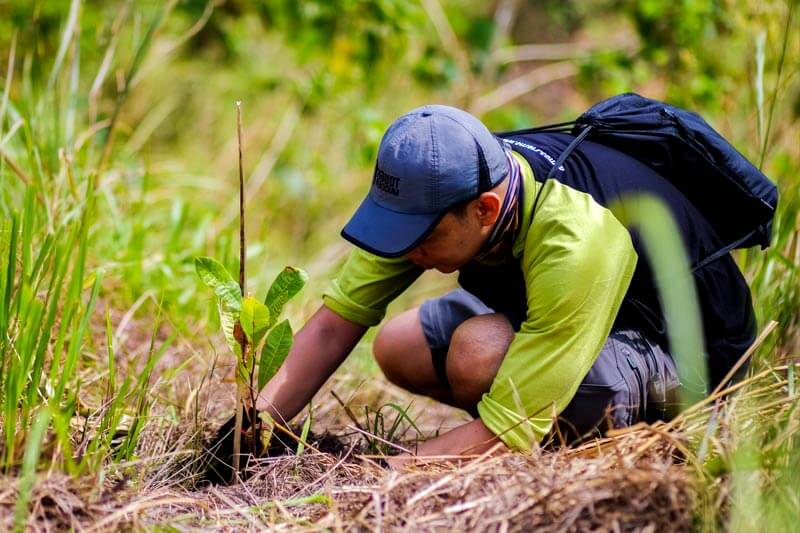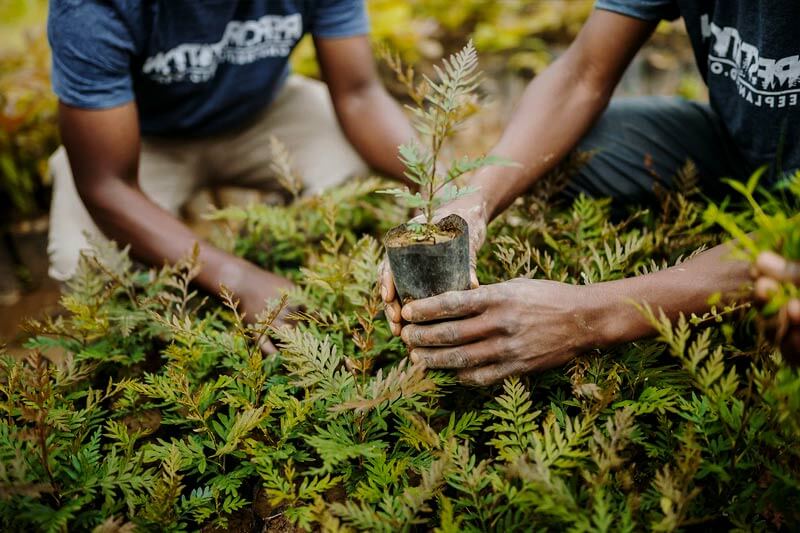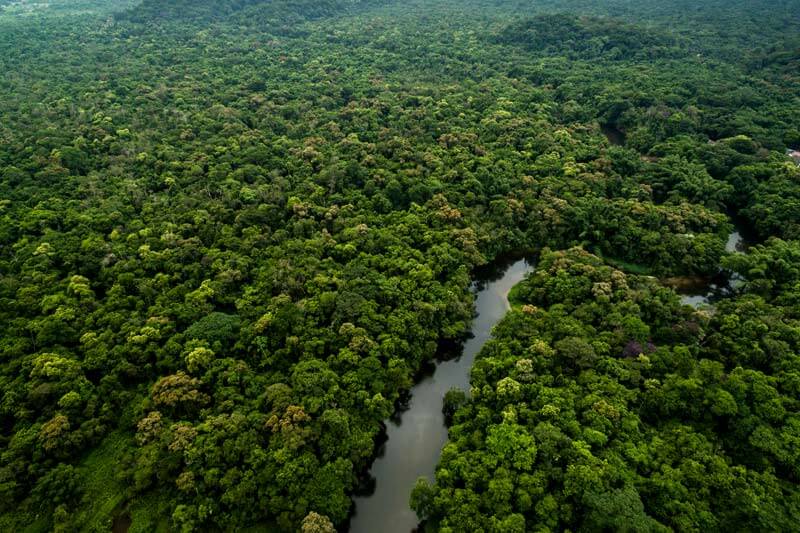Trees stand as crucial components of our planet. They furnish us with fresh air and sustenance, while also playing a pivotal role in safeguarding our water resources.
However, with climate change taking its toll on the world and deforestation being highly on the rise, the need to plant more trees has never been more evident. In 2023 alone, a record 1.83 billion trees1 were planted worldwide.
While this seems like a massive figure, it’s still much lower than the estimated 15.3 billion trees cut down every year.
According to climate ecologists, planting at least 1.2 trillion more trees is our best bet if we’re to upset the impacts of climate change we’re experiencing today.

What we cover
ToggleFacts about planting trees
- There are at least 3.04 trillion trees in the world today. This estimates around 422 trees for each person.
- Before humans existed, an estimated 6 trillion trees existed, showing a decline of nearly 50%.
- Approximately 1.9 billion trees2 are planted every year, according to the United Nations Environmental Program (UNEP).
- The world has space for up to 600 billion mature trees, which won’t compete with agricultural land.
- Due to the massive rates of deforestation and wildfire destruction, millions of acres of forests need new trees.
How many trees are planted each day?
Using the estimated 1.83 billion trees planted annually, our calculations show that around 5 million trees are planted every day. This data works out to around 3,611 trees per minute or around 60 trees per second.
| Interval | Number |
|---|---|
| Trees planted every year | 1,830,000,000 |
| Trees planted every month | 158,000,000 |
| Trees planted every day | 5,000,000 |
| Trees planted every minute | 3,611 |
| Trees planted every second | 61 |
Nonetheless, these figures aren’t accurate since most organizations and government environmental bodies aren’t too keen on maintaining accuracy in their records. The same applies to farmers and private companies.

Tree planting by country
As you would expect, the richest and biggest countries lead the way with tree-planting initiatives. This is in their effort to balance out the number of trees cut to the number they replant.
China sits at the top, with the number of trees they planted in 2021 standing at nearly 2.5 billion trees.
Nevertheless, this number is set to increase massively since the country announced its plan to plant at least 36,000 square kilometers of trees each year up to 2025. This is in line with their goal of attaining a net zero rate in carbon emissions by 2060.
Other countries that have recently beefed up their reafforestation programs include India, Ethiopia, Pakistan, Mexico, Turkey, Peru, Nigeria, Kenya, and the United States.
The table below shows how each country in the world ranks regarding the number of trees they planted in the past few years.
| Name Of Country | Number Of Trees Planted | Position/Ranking In The World |
|---|---|---|
| China | 2,407,149,493 | 1 |
| India | 2,159,420,898 | 2 |
| Ethiopia | 1,725,350,234 | 3 |
| Pakistan | 1,006,776,724 | 4 |
| Mexico | 789,307,032 | 5 |
| Turkey | 711,103,088 | 6 |
| Peru | 646,502,236 | 7 |
| Nigeria | 626,725,667 | 8 |
| Kenya | 534,680,609 | 9 |
| United States | 315,586,982 | 10 |
| Ghana | 220,571,208 | 11 |
| Italy | 211,269,211 | 12 |
| Myanmar | 192,154,935 | 13 |
| Philippines | 187,393,371 | 14 |
| Tanzania | 159,635,654 | 15 |
| Brazil | 144,078,245 | 16 |
| Cuba | 137,476,944 | 17 |
| Canada | 137,302,121 | 18 |
| Algeria | 128,124,520 | 19 |
| Burundi | 119,430,669 | 20 |
| Indonesia | 115,216,883 | 21 |
| Spain | 107,675,557 | 22 |
| Romania | 66,578,366 | 23 |
| South Korea | 58,725,859 | 24 |
| France | 40,510,631 | 25 |
| Estonia | 39,009,236 | 26 |
| Venezuela | 36,702,957 | 27 |
| Azerbaijan | 34,382,212 | 28 |
| Afghanistan | 34,019,233 | 29 |
| Benin | 30,742,992 | 30 |
| Morocco | 28,004,559 | 31 |
| Costa Rica | 25,518,682 | 32 |
| Belgium | 23,785,880 | 33 |
| Uganda | 21,866,960 | 34 |
| Tunisia | 21,008,735 | 35 |
| Senegal | 20,134,702 | 36 |
| Paraguay | 20,009,395 | 37 |
| Chile | 18,013,132 | 38 |
| Guatemala | 16,607,081 | 39 |
| United Kingdom | 14,550,507 | 40 |
| Japan | 14,093,513 | 41 |
| Colombia | 13,795,002 | 42 |
| Norway | 12,788,611 | 43 |
| Sri Lanka | 12,242,859 | 44 |
| Sierra Leone | 12,002,662 | 45 |
| Australia | 11,908,134 | 46 |
| Malaysia | 10,652,529 | 47 |
| Iraq | 10,241,091 | 48 |
| Thailand | 9,026,174 | 49 |
| Ecuador | 8,924,626 | 50 |
| Egypt | 8,542,581 | 51 |
| Germany | 8,523,687 | 52 |
| Taiwan | 7,642,099 | 53 |
| Panama | 7,265,456 | 54 |
| Bangladesh | 6,902,528 | 55 |
| Cameroon | 6,584,745 | 56 |
| Guinea | 6,566,406 | 57 |
| Nicaragua | 6,425,810 | 58 |
| Argentina | 6,157,386 | 59 |
| Gambia | 5,021,900 | 60 |
| Kyrgyzstan | 5,000,000 | 61 |
| South Africa | 4,862,997 | 62 |
| Austria | 4,574,901 | 63 |
| United Arab Emirates | 4,225,576 | 64 |
| Israel | 4,110,451 | 65 |
| Congo-Brazzaville | 3,962,389 | 66 |
| Nepal | 3,575,197 | 67 |
| Malawi | 3,330,822 | 68 |
| Zambia | 3,298,344 | 69 |
| Jordan | 2,607,803 | 70 |
| Armenia | 2,368,641 | 71 |
| Poland | 2,340,731 | 72 |
| Timor-Leste | 2,155,000 | 73 |
| Sweden | 2,126,561 | 74 |
| Albania | 2,045,300 | 75 |
| New Zealand | 1,970,374 | 76 |
| Portugal | 1,655,575 | 77 |
| Congo-Kinshasa | 1,554,353 | 78 |
| Mali | 1,516,153 | 79 |
| Ireland | 1,464,908 | 80 |
| Madagascar | 1,423,385 | 81 |
| Rwanda | 1,404,081 | 82 |
| Netherlands | 1,301,800 | 83 |
| Laos | 1,166,249 | 84 |
| Mozambique | 1,127,183 | 85 |
| Fiji | 1,077,897 | 86 |
| Mongolia | 1,041,376 | 87 |
| Turkmenistan | 880,001 | 88 |
| Cambodia | 833,582 | 89 |
| Burkina Faso | 693,355 | 90 |
| Montenegro | 650,837 | 91 |
| Bolivia | 639,298 | 92 |
| Sudan | 610,981 | 93 |
| Mauritius | 561,885 | 94 |
| Mauritania | 475,230 | 95 |
| Serbia | 424,452 | 96 |
| Haiti | 423,243 | 97 |
| Zimbabwe | 408,356 | 98 |
| Togo | 367,165 | 99 |
| Brunei | 336,459 | 100 |
Source: World Tree Map: 2020
Are we planting more trees than we are cutting down?
No! While there are more tree-planting initiatives and participants today than ever before, the increase in the world population has meant an increase in the rate of deforestation.
To put this into perspective, we lose at least 15.3 billion trees every year to deforestation while our tree planting rate stands at 1.83 billion trees annually.
This represents a disparity ratio of 1:8 between the number of trees planted vs. those cut-down. However, this isn’t a reason to lose hope.
Over the recent years most nations, both developed and developing, are putting more emphasis on tree planting initiatives.

Some of the most ambitious and game-changing programs include:
Rwanda tree planting
As of late last year, Rwanda announced a plan to plant over 43 million trees in just two months. The small African country is doing this as part of its plan to reduce its carbon emissions by 38% by 2030.
They’re also dedicated to restoring at least 2 million hectares of their degraded land by 2030.
While this may seem overly ambitious, it’s actually not. Rwanda was able to attain the goal of increasing its forest cover to 30% in 2019, one year earlier than its 2020 target.
The great green wall
Another promising tree-planting initiative is the Great Green Wall program happening in some Sub-Saharan countries. The project aims at creating an 8,000-kilometer forest ‘wall’ cutting across the continent.
The countries involved in this project include Senegal, Burkina Faso, Chad, Djibouti, Sudan, Eritrea, Ethiopia, Mali, Mauritania, Niger, and Nigeria.
The project started in 2007 and it’s already changing the degraded landscape of the affected areas.
India’s tree boom
Over the past three years, India’s forest cover has grown by over 870 square miles or around 2,261 square kilometers. While these figures don’t indicate such massive growth, the calculations involved also account for the deforestation activities taking place.
This proves that the country is planting more trees than it’s losing, which is good news. Among the most successful tree-planting efforts in the country includes their 2016 tree drive that saw Indians in Uttar Pradesh plant 50 million trees in just one day!
In 2017, a similar initiative in Madhya Pradesh saw thousands of volunteers plant more than 66 million trees!
Pakistan’s 10 Billion tree tsunami
In 2018, the government of Pakistan set out on an ambitious project of planting around 10 billion trees by 2023. Dubbed the, 10 Billion Tree Tsunami, this program rides on the success of the previous re-afforestation program called the 1 Billion Tree Tsunami that started in 2014.
If successful, this program is expected to drastically change and restore the landscape of Pakistan, increase employment opportunities, as well as help protect the natural resources in the country.
As of June 2021, the government records that around 1 billion trees were already planted.
Ethiopia tree planting
In July of 2019, Ethiopia made it to the Guinness Book of Records by planting a whopping 350 million trees in just 12 hours! The initiative was part of the country’s ‘Green Legacy’ project that aims to plant 20 billion trees by 2022 to help combat the adverse effects of climate change.
As of 2021, the country had planted an estimated 18.7 billion seedlings, which is 7 million more than they anticipated.
If this initiative is successful, which seems highly likely, the results will be a game-changer for the East African country. It’ll also serve as the roadmap for other African countries on how to implement tree-planting projects successfully.
Trillion Tree Campaign
The Trillion Tree campaign is a project by the United Nations Environment Programme. It was inspired by the late Nobel Prize Winner, Professor Wangari Maathai, in 2006.
While it started as the billion trees campaign, that target was quickly hit in 2007, forcing UNEP to update its targets. Since then, the 7 billion target set was again hit in 2009, the 12 billion target was achieved in 2015, and the 15 billion target in 2017.
The goal now is to plant one trillion trees across the world.
What is being done to encourage new planting?
A lot is happening around the world to encourage tree planting. The game-changer, however, has been the recognition and involvement of governments and organizations in tree planting.
As more governments get alarmed at the rate of deforestation in their nations, they put in place policies to promote tree reafforestation.
Private organizations and NGOs are also playing a key role in initiating and implementing tree-planting projects. In just under 10 years, these players have contributed to the planting of more than 5 billion trees worldwide.
If this trend continues, we’re likely to completely achieve the estimated one trillion trees required to revert the effects of climate change.
Start in your local community
If you are reading this article and wondering what you can do to help the cause, consider planting a tree in your garden. If everybody planted one tree each year, we would not have a global warming problem.
If you are unsure how to plant a tree, please see our guide on best practices.
FAQ's
There are only 4 countries in the world with no forest. They include Qatar, Greenland, Oman, and San Marino. This, however, doesn’t mean there are no trees in these countries, it just means that the trees there don’t meet the World Bank’s definition of a forest.
The world has a population of around 8 billion people. If each of us planted a tree, that would mean 8 billion more trees added to the planet. While this won’t be enough to revert climate change, it’s a valuable step to helping cool the planet.
Around 1.83 billion trees are planted every year globally. This equates to around 5 million trees planted every day.
Tree Vitalize, (2023) How Many Trees Planted Per Year <https://treevitalize.com/tree-planting-statistics/> Accessed: 09-02-2024.
Hailong, (2023) Comprehensive Analysis: How Many Trees Are Planted Each Year? <https://www.tenereteam.com/blogs/how-many-trees-are-planted-each-year/> Accessed: 09-02-2024.




